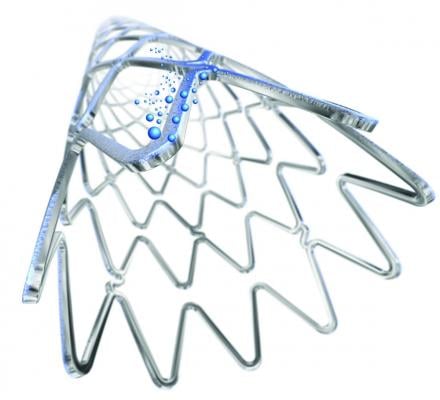
November 7, 2016 – The two-year results from LEADERS FREE, the first randomized clinical trial dedicated to high bleeding risk patients treated with one month of dual antiplatelet therapy (DAPT), found that a polymer-free drug-coated stent (DCS) remained both significantly safer and more effective than the comparator bare-metal stent (BMS) used in the trial.
Findings were reported at the 28th annual Transcatheter Cardiovascular Therapeutics (TCT) scientific symposium. The study was also simultaneously published in The Journal of the American College of Cardiology (JACC).
Patients with a high bleeding risk (HBR) comprise approximately 20% of patients treated by PCI, yet they are usually excluded from trials of devices and antithrombotic drug regimen. Current recommendations for high-risk patients are one month of DAPT after BMS implantation and a “shortened” DAPT regimen after DES (however, usually a minimum 3-6 months). LEADERS FREE examined the use of one month of DAPT for both types of stents, specifically studying the Biosensors’ BioFreedom DCS, which releases biolimus A9 into the vessel wall over a period of four weeks without the use of a polymer to aid drug delivery.
“The two-year results from the LEADERS FREE trial clearly show that the use of a polymer free biolimus A-9 coated stent was both significantly safer and more effective than a bare-metal stent for patients at high risk of bleeding treated with a one-month course of DAPT,” said lead investigator, Philip M. Urban, M.D., director of invasive cardiology at La Tour Hospital in Geneva, Switzerland. “These patients suffer from a persistently high incidence of bleeding and coronary thrombotic events, both of which are associated with a high and similar mortality over a one-year period. Therefore, identification of predictors of both the composite primary safety event and major bleeding may help design future trials of DAPT duration for this population.”
The prospective double-blind randomized study enrolled 2,466 patients with high bleeding risk during PCI from 68 centers in Europe, Asia and Canada. Patients were randomized (1:1) to receive a DCS (N=1,221) or BMS (N=1,211). The primary safety endpoint was a composite of cardiac death, myocardial infarction (MI), or stent thrombosis (ST). The primary efficacy endpoint was clinically driven target-lesion revascularization (cd-TLR). The one year results were presented at last year’s TCT meeting, and demonstrated superior safety and efficacy of DCS at one year.
A total of 97.7% (1,193) of DCS and 98.3% (1,191 BMS) of surviving patients had follow-up data available for analysis at two years. The primary safety endpoint at two years was 12.6% for DCS compared to 15.3% for BMS (HR 0.80; 95%CI, 0.64-0.99; P=0.039). The results for the primary efficacy endpoint of clinically driven TLR at two years were 6.8% for DCS versus 12.0% for BMS (HR 0.54; 95%CI, 0.41-0.72; P<0.0001).
Major bleeding occurred in 8.9% DCS and 9.2% BMS patients (P=0.95), and a coronary thrombotic event (MI and/or ST) in 8.2% DCS and 10.6% BMS patients (P=0.045). Of note, confirming the relative importance of both thrombotic and bleeding events, subsequent mortality was 27.1% one year after a major bleed, and 26.3% one year after a thrombotic event.
Read about the one-year results from the LEADERS FREE Trial.
The LEADERS FREE trial was funded by Biosensors Europe. Urban disclosed consulting fees/honoraria from Biosensors Europe, Edwards Lifesciences, Abbott Vascular, and Sinomed. He is also a medical director and shareholder at CERC (Massy, France).
For more information: www.crf.org


 December 20, 2023
December 20, 2023 








